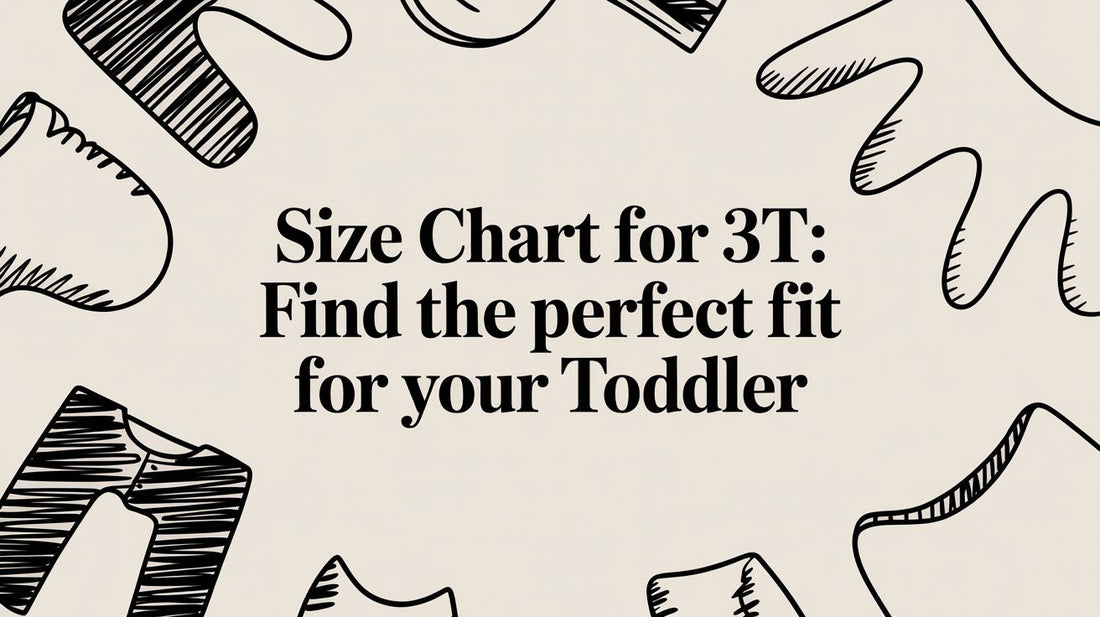
Navigating the world of toddler clothing can feel like a guessing game, especially when you hit that tricky 3T size. As a general rule, a 3T size is meant for toddlers who weigh between 30-34 pounds and are about 35-39 inches tall.
But here’s the inside scoop: the "T" in 3T stands for Toddler, and it's more about the shape of the clothes than the age of your child. This special cut is designed to fit a classic toddler build.
What a 3T Size Chart Actually Means
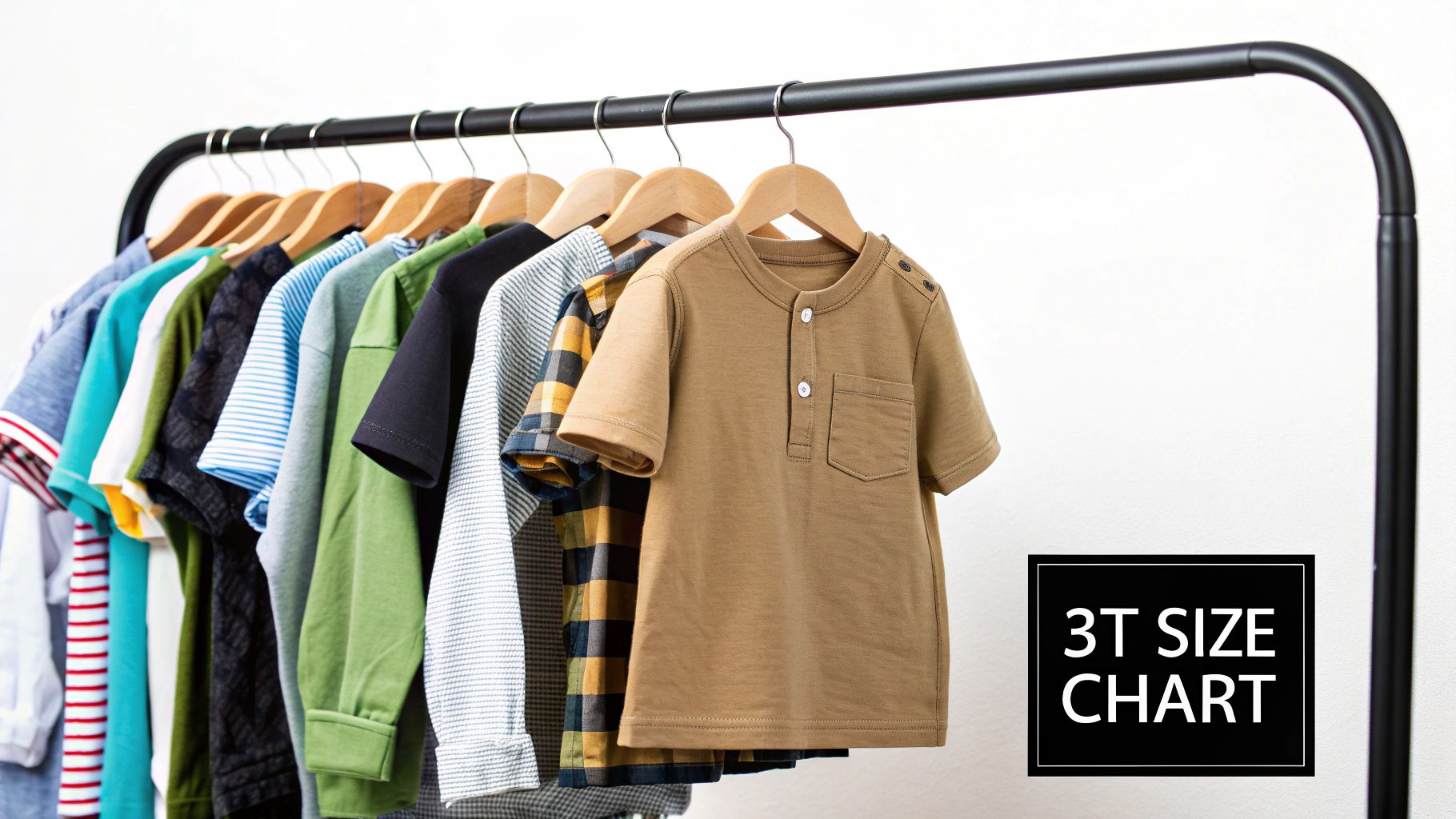
It’s completely normal to think "3T" is just for three-year-olds. While that's often the case, the real secret is in the fit. Toddler sizes are cut differently than standard kids' sizes because toddlers still have that adorable, pot-belly shape and a shorter torso.
This is the biggest difference between a 3T and a regular kids' size 4. A size 4 is made for a slightly older child who is starting to get taller and leaner. A 3T, on the other hand, gives them that much-needed extra room in the tummy and is proportioned for a shorter, sturdier frame.
Key 3T Measurement Ranges
To really nail the perfect fit, you have to look past the age on the tag and focus on your child's actual measurements. For a quick reference, here's what most brands consider standard for 3T clothing.
Standard 3T Size Chart Measurements
| Measurement | Imperial (Inches/Pounds) | Metric (cm/kg) |
|---|---|---|
| Height | 35 - 39 inches | 89 - 99 cm |
| Weight | 30 - 34 pounds | 13.6 - 15.4 kg |
| Chest | 21 inches | 53 cm |
| Waist | 20.5 inches | 52 cm |
These numbers are your best friends when shopping. If your little one's height and weight fall within these ranges, 3T clothes should give them a comfortable and well-proportioned fit that allows for plenty of play.
Parenting Tip: Always, always go by your toddler's current height and weight, not their age. Every child grows at their own pace, and these two measurements are the only way to get a truly accurate fit.
For a bigger picture of how sizing evolves as your child grows, take a look at our complete kids' clothing size chart. It's a great resource to have on hand for every growth spurt, making sure your kiddo is always comfy in their clothes.
How to Measure Your Toddler for a Perfect Fit
Okay, let's be real. Knowing what the numbers on a 3T size chart mean is one thing. Actually getting those measurements from a wiggly, super-active toddler? That's a whole different ball game. The secret is to make it fun and quick—turn what could be a wrestling match into a little game.
You don't need any fancy or rigid tools. Just grab a soft, flexible measuring tape, like the kind used for sewing. It’s way more comfortable for them and won't feel cold or pokey on their skin.
Getting the Key Measurements
You really only need three simple measurements to nail the fit for most shirts, pants, and dresses.
- Height: Have your toddler stand tall with their back against a wall. Make a tiny, light pencil mark right at the top of their head, then measure from the floor up to that mark. You can make it fun by showing them how much they've grown since the last time!
- Chest: To get this right, wrap the soft tape around the fullest part of their chest, just under their armpits. Keep the tape level and snug, but not so tight that it's squeezing them.
- Waist: Simply wrap the tape around their natural waistline, which is usually right above their belly button. This is where the waistband of their pants or skirt will naturally sit.
This chart gives you a great visual for the typical ranges you’ll find for 3T clothing.
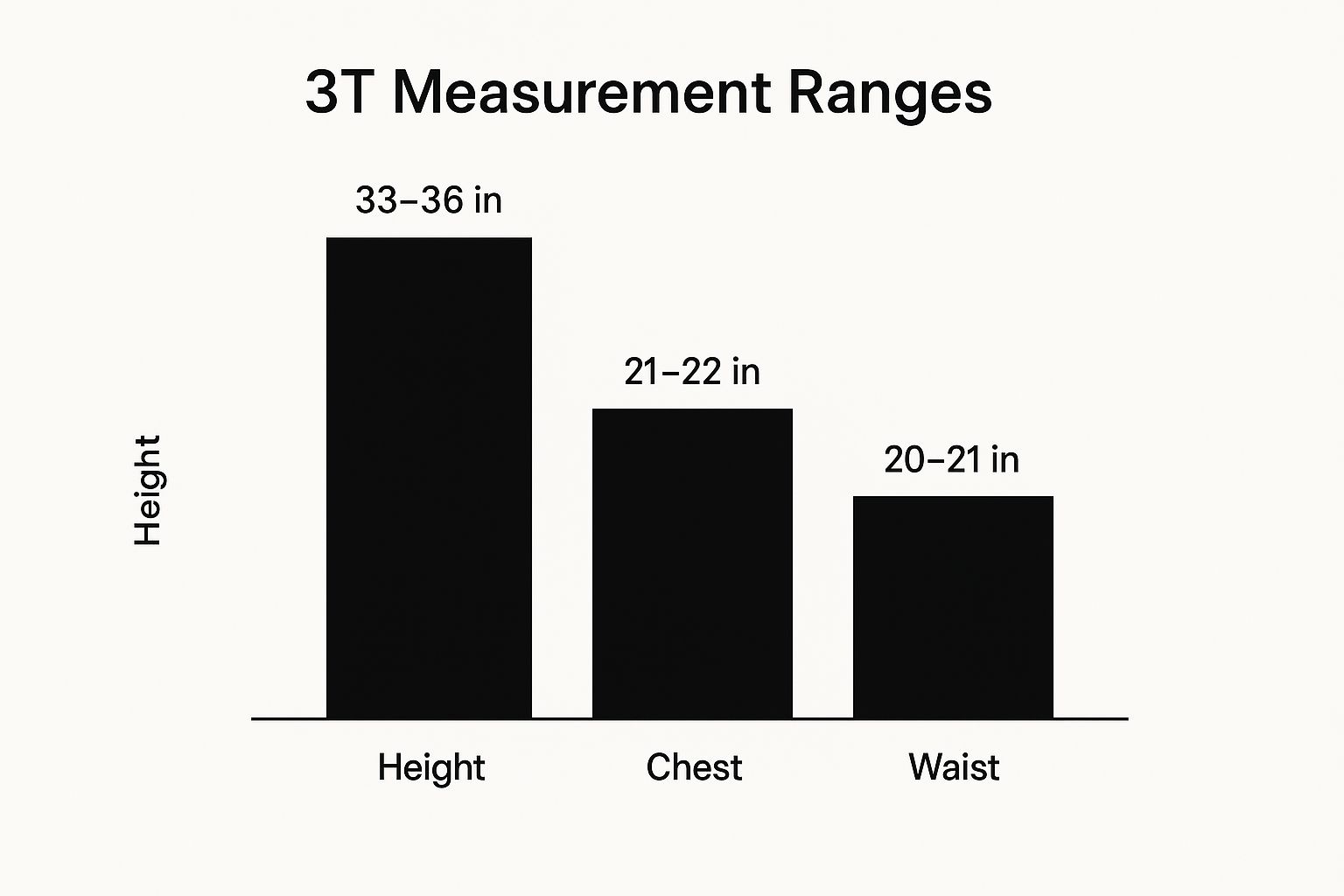
As you can see, height is often the biggest factor in toddler sizing. The chest and waist measurements usually fall within a much tighter range.
Pro Tip: For the most accurate numbers, measure your child while they're just in their underwear or a very thin layer of clothing. A bulky sweater or a pair of jeans can easily add extra inches and throw off the fit.
Taking a few moments to get these measurements will save you so much guesswork and help you shop with confidence. It’s the best way to cut down on the hassle of online returns. For more advice, our children's clothes height guide is a fantastic resource for finding the perfect fit as they keep on growing.
Navigating International Size Differences
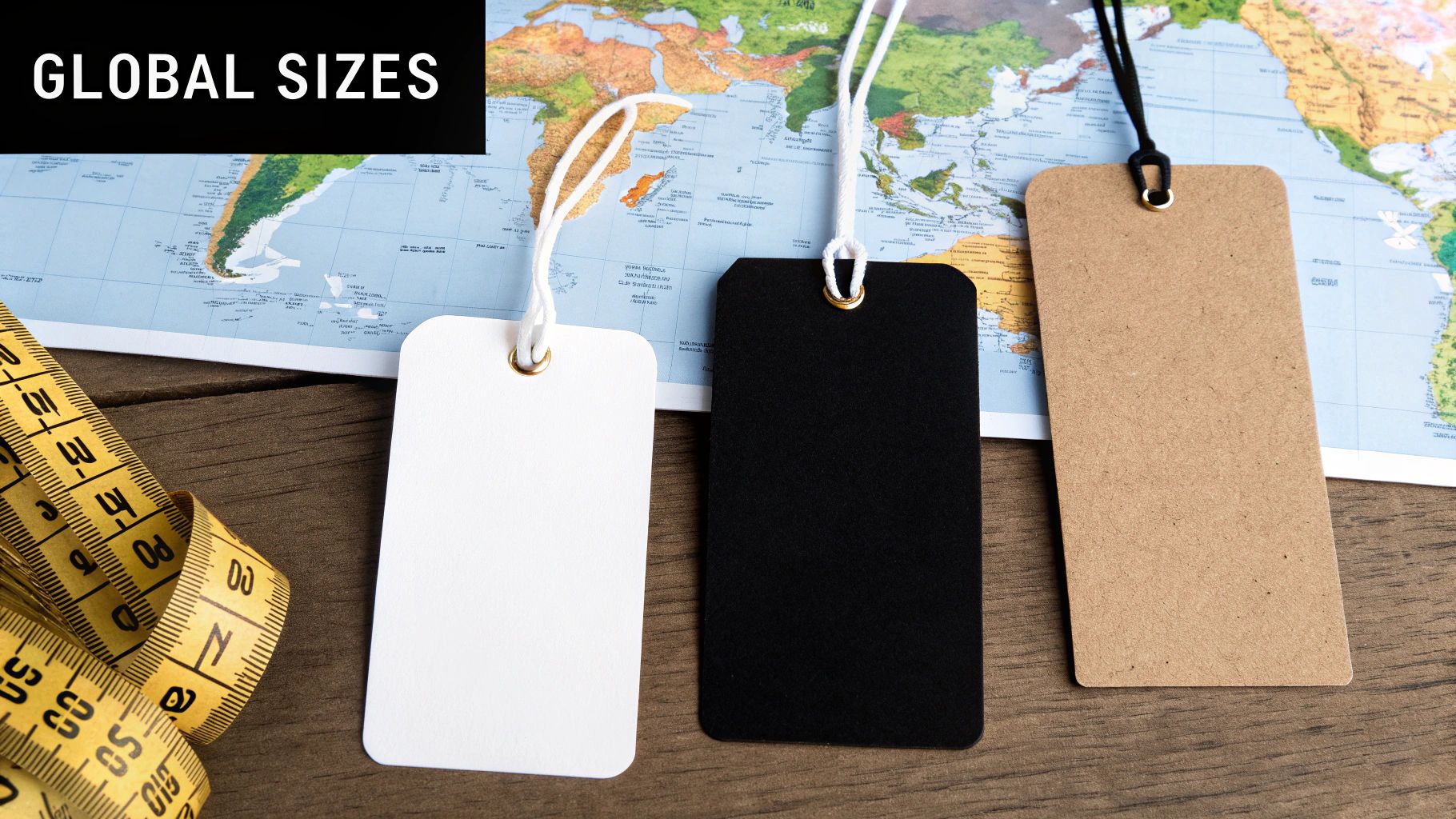
Shopping online opens up a wonderful world of adorable toddler clothes from all over the globe. But it also introduces a confusing maze of sizing systems. If you've ever stared at a European size like "98" and wondered what on earth it has to do with a US 3T, you are definitely not alone.
The main thing to remember is that most international sizing, especially in Europe, is based on a child’s height in centimeters. Honestly, it's a much more practical way to shop than just going by age, since it ties the size directly to the length of the clothes. A US 3T is typically for a toddler who is about 35-39 inches tall, which is roughly 89-99 centimeters.
Cracking the Conversion Code
Once you know that, it’s easy to see why a US 3T often lines up with a European size 98. It’s all about the height!
Meanwhile, places like the UK and Australia usually stick to age ranges, so you'll find 3T is similar to their "3-4 Years" size, which gives your little one some room to grow. In Japan, they also use height, so a size "100" is a common equivalent for a child in that height range.
Here’s a quick cheat sheet to help you see the common conversions at a glance.
US 3T International Size Conversion Chart
| US Size | European Size (Height in cm) | UK / AUS Size (Years) | Japanese Size (Height in cm) |
|---|---|---|---|
| 3T | 98 | 3-4 | 100 |
Just remember, these are close equivalents, not perfect matches. Brands can have their own quirks, and you might see a 10-20% difference in the actual fit of the clothes. This is what can make international shopping so tricky! To learn more about how sizing varies globally, you can discover insights about international size charts on Labeloom.com.
Shopping Globally: When you’re buying from an international brand, always, always look for their specific size chart. Measuring your child’s height in centimeters and using that as your guide is the single best thing you can do to get the fit right.
Having a handy conversion guide can make a world of difference. It's especially crucial for items like pants where length is everything. If you want to dive deeper, you can explore our dedicated guide on the topic by checking out our kids' pants size chart. It’ll give you the confidence to click "add to cart" no matter where the brand is from.
Why a 3T from One Store Isn't the Same as Another
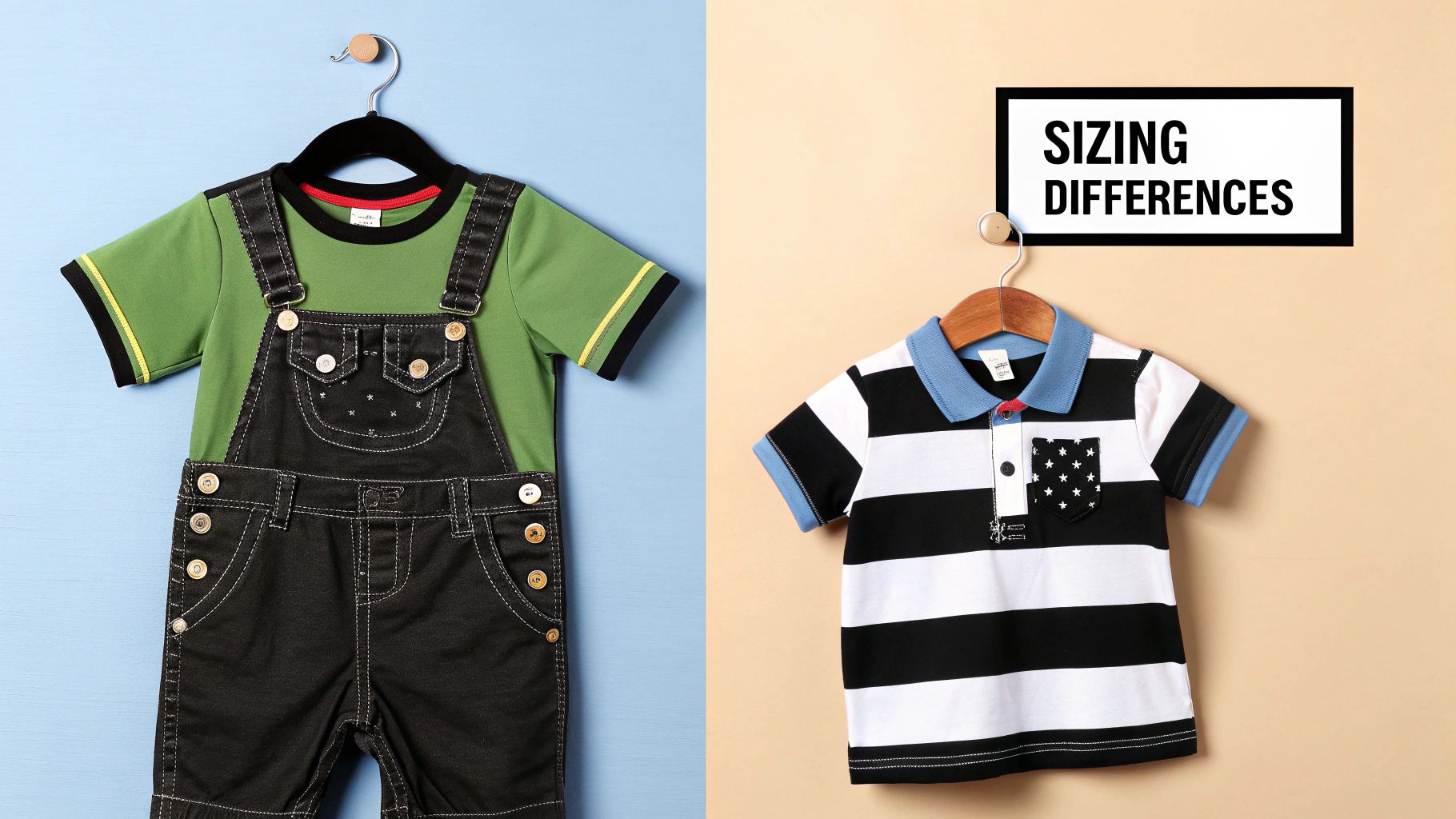
If you've ever felt a little crazy after a 3T from one brand fits perfectly while another is way too tight, you're not imagining things. It’s one of the biggest headaches for parents, and it happens for a simple reason: there’s no legally required sizing standard for kids' clothing.
Every brand creates its own size chart for 3t garments, designing for what they consider their "average" toddler. Think of it less like a science and more like an art—each company has its own interpretation of what a 3-year-old looks like.
Fit Models and Fabrics Make All the Difference
One of the biggest reasons for these frustrating inconsistencies comes down to "fit models." Brands will literally hire a specific child and build their entire sizing pattern around that child's body shape. If a brand uses a tall, slender toddler as their model, their 3T clothes will likely run long and narrow. Another company might design for a toddler with a rounder tummy, resulting in a roomier fit.
The material itself also changes everything.
- Stretchy Fabrics: A cotton jersey or anything with spandex is built to be forgiving. There’s a lot of wiggle room.
- Woven Fabrics: Materials like denim, twill, or corduroy have almost no natural stretch, so the sizing has to be much more exact.
Key Takeaway: That "3T" on the tag is really just a suggestion. It's a starting point, not a universal rule. It reflects that specific brand's idea of what a 3-year-old should be wearing.
This is a huge deal in the massive toddler clothing market, an industry projected to blow past USD 265 billion in 2024. As more of us shop online, getting a handle on these variations saves a ton of time on returns. You can learn more about the latest toddler wear market trends on GrandViewResearch.com.
At the end of the day, the measuring tape is your best friend. Always trust your child's actual measurements over the number printed on the label.
Pro Shopping Tips for 3T Clothes
Okay, you've got your toddler's measurements and you know that sizes can be a bit all over the place. Now comes the fun part: shopping. A little strategy here goes a long way, saving you from the headache of returns and a closet full of clothes that don't quite fit.
The first and most important habit to build? Treat every brand like its own unique universe. Before you even think about clicking "add to cart," hunt down that brand's specific size chart for 3t clothes. Think of the "3T" on the tag as a starting point, but the brand's chart is your real road map.
Building a Wardrobe That Actually Fits
Looking beyond the chart, a few savvy habits will help you nail the fit every time and get more mileage out of each piece of clothing.
- Read the Reviews: This is gold. Other parents are your best resource. Scan the comments for phrases like "runs small," "true to size," or "generous fit." This is the kind of real-world intel you just can't get from a chart.
- Look for Adjustable Features: Keep an eye out for clothes designed to grow with your child. Things like elastic waistbands, adjustable straps, and cuffs you can roll up or down can easily add months of wear to an outfit.
- Try Before You Buy (a Lot): If you're experimenting with a new brand, don't go all in at once. Buy just one or two pieces to see how their sizing really fits your toddler in person. It’s a small test that can prevent a big, expensive mistake.
The Golden Rule of Toddler Shopping: When in doubt, trust the measuring tape and parent reviews over the size on the tag. A few minutes of prep work saves you from the hassle of a trip to the post office later.
Once you get into this rhythm, shopping stops being a guessing game. You’ll start building a collection of clothes that not only look great but are also comfortable and ready for whatever adventure your toddler dives into next.
Common Questions About 3T Sizing
Even with the best charts in hand, a few questions always seem to pop up when you're trying to wrangle a toddler into the right-sized clothes. Let's tackle some of the most common head-scratchers so you can shop with total confidence.
Think of this as your go-to cheat sheet for decoding the quirks of a size chart for 3t clothing.
What Is the Real Difference Between 3T and 4T?
This is probably the number one question parents ask. The jump from 3T to 4T seems small, but it's a huge leap in how clothes are actually cut. The difference isn't just about adding an inch here or there; it's about a fundamental shift in your child's body shape.
A 3T is cut for a classic toddler build. That means it has a little extra room in the tummy and seat to make space for a diaper (or a recently potty-trained belly!). The sleeves and inseams are also shorter, designed for that adorable, compact toddler frame.
A 4T, on the other hand, is designed for a preschooler who's starting to stretch out and slim down. Their body is becoming more proportional, with a longer torso and leaner limbs. Because of this, 4T clothes are cut longer and narrower than 3T, even if the weight recommendations overlap.
The Bottom Line: A 3T is for a rounder, shorter toddler shape. A 4T is for a taller, leaner preschooler shape. It’s less about their age and more about their current body proportions.
Is 3T the Same As 3-4 Years?
Here’s another common mix-up, especially if you're shopping from European or UK brands. They sound like they should be the same, but a US 3T and a UK “3-4 Years” size are definitely not interchangeable.
A 3T is meant to fit an average three-year-old right now. It’s tailored to the height and weight measurements common for that age.
A “3-4 Years” size is designed with growth in mind. It’s meant to fit a child throughout the entire year they are three and heading towards four. This usually means it will start out a bit bigger and roomier than a standard 3T to leave space for those inevitable growth spurts.
- US 3T: Fits an average 3-year-old’s current measurements.
- UK/EU "3-4 Years": Designed with growing room to last from age 3 to 4.
When in doubt, especially with international brands, always ignore the age label and go straight to the brand’s specific height and weight chart.
When Should I Size Up in 3T Clothes?
Ah, the classic dilemma: buy for now or buy for later? The decision to stick with their current size or size up is a strategic move that really depends on the item of clothing and your child's growth pattern. There’s no single right answer, but a few simple guidelines can help.
Consider sizing up for:
- Outerwear: A winter coat or snowsuit needs extra room for layering chunky sweaters underneath. Sizing up is a smart bet to make sure it lasts the whole season.
- Brands That Run Small: If you've seen reviews that a brand's sizing is on the smaller side, trust the feedback from other parents and go up a size from the start.
- Growth Spurts: If your toddler feels like they're growing an inch overnight, buying a size larger for key items can save you from having to shop again in a month.
For everyday clothes like t-shirts and leggings, though, a proper fit is often safer and more comfortable. Pants that are too long can be a serious tripping hazard on the playground. A good rule of thumb is to buy everyday essentials true-to-size and save the sizing-up strategy for those bigger-ticket items you want to last a little longer.
At Yarafly, LLC, we make finding the perfect fit simple with detailed size charts and a wide range of playful, comfortable styles for every stage. Explore our durable and adorable toddler collections today.
Article created using Outrank